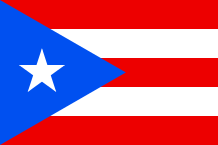PUERTO RICO
 Situated east of the Dominican Republic, Puerto Rico is the smallest island of the Greater Antilles (Cuba, Dominican Republic, Haiti and Jamaica). It is 61 km long and 56 km wide. With its cays and islets (Vieques, Culebra, Caja de Muertas, Palominos, Cayo Icacos, Cayo Luis Peña…). Puerto Rico’s area is 9 060 sq km.
Situated east of the Dominican Republic, Puerto Rico is the smallest island of the Greater Antilles (Cuba, Dominican Republic, Haiti and Jamaica). It is 61 km long and 56 km wide. With its cays and islets (Vieques, Culebra, Caja de Muertas, Palominos, Cayo Icacos, Cayo Luis Peña…). Puerto Rico’s area is 9 060 sq km.
This island has some valleys and also numerous mountains such as, in the centre Cordillera Central with its highest point, Cerro de Punta (1341 km) and Cerro de los Tres Picachos ; Sierra del Luquillo, in the east, with its two peaks, El Yunque and El Toro ; Sierra de Cayey, in the south-east ; Sierra Bermeja and Bosque de Guánica, in the south-west ; Montañas de Uroyan, in the south ; Cordillera Jaicoa and Montañas Guarionex, in the north-west.
Several rivers flows in the island. The tropical rainforest of Yunque accomodates over 60 species of bird, in particular the endemic Puerto Rican parrot. The dry forest of Guánica, located near ll;the coast, is home for 130 species of bird. The wild horses brought by the Spanish settlers during the colonization gallop through the Vieques Island. In Puerto Rico, the snakes (in particular the Puerto Rican boa, that can grow over 2m) are numerous. In the coral reefs, there are hundreds of species of fish and turtles.
The economic resources are tourism, sugar, rum, tabacco, coffee, citrus fruits and cocoa. The United States have developed a chemical, textil and food industry. However, over the past decade, the island is confronted with an economic crisis, its debt is 72 billion dollars US (62,5 billion euros). The decision of the United States, in 2006, to cancel tax credit granted to companies to incite them to invest on the island is the cause of this situation. Every week, about 2 000 Puerto Ricans leave the island to find a job in the United States.
Chistopher Columbus discovered Puerto Rico, in 1493. In the past, the island was inhabited by the Amerindians (Tainos) probably arrived from Florida and the Lesser Antilles around 1st century AD. The Tainos named this land Borinquen that means “Land of Great lord” or “Land of Crabs”. Quickly, the island was colonized by the Spaniards when Juan Ponce de León visited it in 1508 for the second time. The “conquistadores” who looked for gold and precious stones did not hesitate to rape, enslave then exterminate the Amerindians. Some of them succeeded in running away and taking refuge in the mountains.
Around 1530, Dutch and French ships began to bring to Puerto Rico hundreds of African slaves (mainly from Yoruba and Mandingo tribes).
In the 16th and 17th century, the English and Dutch waged war on the Spaniards to conquer Puerto Rico. Spain gave up the island to the United States after the Spanish-American War, in 1898.
In 1952, the country became a Commonwealth of the United States of America. This status, confirmed by several elections or referendum (1992-1993-2004), is contested by the Puerto Ricans who want the island becomes the 51st American State and the partisans of the independence movement.
Area : 9 060 sq miles (3 498 sq miles)
Population : 3,4 million inhabitants
Capital : San Juan
Languages : Spanish – English
Currency : US Dollar (US$)
People : Puerto Ricans
